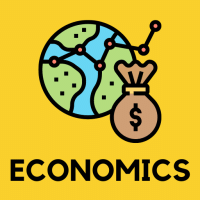Commerce Exam > Commerce Questions > Equilibrium in the labor market requires that...
Start Learning for Free
Equilibrium in the labor market requires that the expected real wage in wage setting be equal to the effective real wage.
- a)True
- b)False
Correct answer is option 'A'. Can you explain this answer?
Verified Answer
Equilibrium in the labor market requires that the expected real wage i...
This is stating the fact that we find the equilibrium level of unemployment by equating the wage-seDng equation to the price seDng equation such that expected real wage equals to the effective realwage.
Most Upvoted Answer
Equilibrium in the labor market requires that the expected real wage i...
Equilibrium in the Labor Market
Equilibrium in the labor market refers to a situation where the demand for labor equals the supply of labor, and there is no excess demand or excess supply of labor. In other words, the labor market is in balance, and there is no upward or downward pressure on wages.
Expected Real Wage
The expected real wage is the wage rate that workers expect to receive for their labor. It is the nominal wage adjusted for inflation. Workers base their expectations on various factors such as their skills, experience, education, and the market conditions.
Effective Real Wage
The effective real wage is the wage rate that workers actually receive for their labor. It is the nominal wage adjusted for inflation. The effective real wage depends on various factors such as the demand for labor, the supply of labor, and the bargaining power of workers.
Equilibrium in the Labor Market and Real Wage
Equilibrium in the labor market requires that the expected real wage in wage setting be equal to the effective real wage. When the expected real wage is higher than the effective real wage, there is excess supply of labor, and workers are willing to work at a lower wage rate. On the other hand, when the expected real wage is lower than the effective real wage, there is excess demand for labor, and employers are willing to pay a higher wage rate to attract workers.
Conclusion
In conclusion, equilibrium in the labor market requires that the expected real wage in wage setting be equal to the effective real wage. When the labor market is in equilibrium, there is no excess demand or excess supply of labor, and the wage rate is stable.
Equilibrium in the labor market refers to a situation where the demand for labor equals the supply of labor, and there is no excess demand or excess supply of labor. In other words, the labor market is in balance, and there is no upward or downward pressure on wages.
Expected Real Wage
The expected real wage is the wage rate that workers expect to receive for their labor. It is the nominal wage adjusted for inflation. Workers base their expectations on various factors such as their skills, experience, education, and the market conditions.
Effective Real Wage
The effective real wage is the wage rate that workers actually receive for their labor. It is the nominal wage adjusted for inflation. The effective real wage depends on various factors such as the demand for labor, the supply of labor, and the bargaining power of workers.
Equilibrium in the Labor Market and Real Wage
Equilibrium in the labor market requires that the expected real wage in wage setting be equal to the effective real wage. When the expected real wage is higher than the effective real wage, there is excess supply of labor, and workers are willing to work at a lower wage rate. On the other hand, when the expected real wage is lower than the effective real wage, there is excess demand for labor, and employers are willing to pay a higher wage rate to attract workers.
Conclusion
In conclusion, equilibrium in the labor market requires that the expected real wage in wage setting be equal to the effective real wage. When the labor market is in equilibrium, there is no excess demand or excess supply of labor, and the wage rate is stable.

|
Explore Courses for Commerce exam
|

|
Question Description
Equilibrium in the labor market requires that the expected real wage in wage setting be equal to the effective real wage.a)Trueb)FalseCorrect answer is option 'A'. Can you explain this answer? for Commerce 2025 is part of Commerce preparation. The Question and answers have been prepared according to the Commerce exam syllabus. Information about Equilibrium in the labor market requires that the expected real wage in wage setting be equal to the effective real wage.a)Trueb)FalseCorrect answer is option 'A'. Can you explain this answer? covers all topics & solutions for Commerce 2025 Exam. Find important definitions, questions, meanings, examples, exercises and tests below for Equilibrium in the labor market requires that the expected real wage in wage setting be equal to the effective real wage.a)Trueb)FalseCorrect answer is option 'A'. Can you explain this answer?.
Equilibrium in the labor market requires that the expected real wage in wage setting be equal to the effective real wage.a)Trueb)FalseCorrect answer is option 'A'. Can you explain this answer? for Commerce 2025 is part of Commerce preparation. The Question and answers have been prepared according to the Commerce exam syllabus. Information about Equilibrium in the labor market requires that the expected real wage in wage setting be equal to the effective real wage.a)Trueb)FalseCorrect answer is option 'A'. Can you explain this answer? covers all topics & solutions for Commerce 2025 Exam. Find important definitions, questions, meanings, examples, exercises and tests below for Equilibrium in the labor market requires that the expected real wage in wage setting be equal to the effective real wage.a)Trueb)FalseCorrect answer is option 'A'. Can you explain this answer?.
Solutions for Equilibrium in the labor market requires that the expected real wage in wage setting be equal to the effective real wage.a)Trueb)FalseCorrect answer is option 'A'. Can you explain this answer? in English & in Hindi are available as part of our courses for Commerce.
Download more important topics, notes, lectures and mock test series for Commerce Exam by signing up for free.
Here you can find the meaning of Equilibrium in the labor market requires that the expected real wage in wage setting be equal to the effective real wage.a)Trueb)FalseCorrect answer is option 'A'. Can you explain this answer? defined & explained in the simplest way possible. Besides giving the explanation of
Equilibrium in the labor market requires that the expected real wage in wage setting be equal to the effective real wage.a)Trueb)FalseCorrect answer is option 'A'. Can you explain this answer?, a detailed solution for Equilibrium in the labor market requires that the expected real wage in wage setting be equal to the effective real wage.a)Trueb)FalseCorrect answer is option 'A'. Can you explain this answer? has been provided alongside types of Equilibrium in the labor market requires that the expected real wage in wage setting be equal to the effective real wage.a)Trueb)FalseCorrect answer is option 'A'. Can you explain this answer? theory, EduRev gives you an
ample number of questions to practice Equilibrium in the labor market requires that the expected real wage in wage setting be equal to the effective real wage.a)Trueb)FalseCorrect answer is option 'A'. Can you explain this answer? tests, examples and also practice Commerce tests.

|
Explore Courses for Commerce exam
|

|
Signup for Free!
Signup to see your scores go up within 7 days! Learn & Practice with 1000+ FREE Notes, Videos & Tests.























